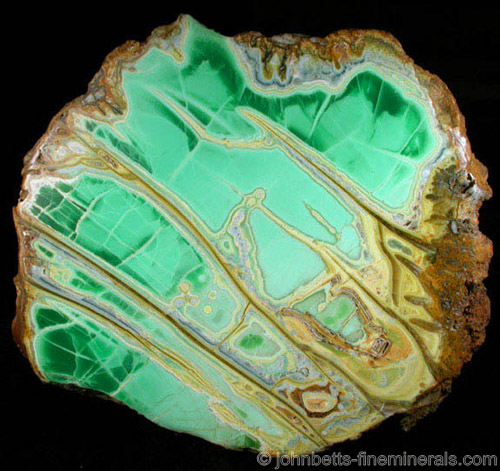The Mineral variscite

Variscite is an important phosphate mineral that is best-known in different shades of green. A highly desired form
of this mineral are the exceptional nodules
from Utah which are cut and polished as slabs or halves of nodules. These formations are usually associated with other phosphates and have interesting veins and color habits.
Variscite may alter into other phosphate
minerals, especially in its nodular form. It is often only partially
altered, such as in yellowish to white layers or veins within a
nodule that have been transformed to Crandallite.
Variscite is the end member of a series with
Strengite,
with Variscite being the aluminum-dominant member and Strengite being
the iron-dominant member. Variscite sometimes contains some iron in its
structure. The color
caused by iron will dominate, and will cause some Variscite to
have a violet or reddish color even if there is less iron than aluminum
present.
Variscite is named after the German district of Variscia, where this mineral was
first found. Variscia is the old historical name of the current region of Vogtland.
For additional information, see the gemstone section on Variscite.
Chemical Formula
AlPO4 · 2(H2O)
Color
Light green to emerald-green, apple-green, and bluish-green. Rarely purple, orange, pink, red, brown, or yellow. Often splotchy or multicolored with different shades of green.
Crystal System
Orthorhombic
Properties
Streak
White |
Hardness
3.5 - 4.5 |
Transparency
Translucent to opaque. Rarely transparent. |
Specific Gravity
2.5 - 2.6 |
Luster
Vitreous, waxy |
Cleavage
1,1;2,1 |
Fracture
Splintery, uneven |
Tenacity
Brittle |
Uses
The polished, emerald-green nodules of Variscite that originate in Utah are highly valued among collectors. Variscite is also used a minor green, often splotchy, opaque gemstone.
Noteworthy Localities
The finest localities for this mineral are in Utah. The most outstanding and best-known is Clay Canyon, near Fairfield, Utah County, where this mineral is found in veined nodules with other phosphates. Fairfield Variscites are usually sliced and polished for collectors, and their color ranges from light bluish-green to deep emerald-green. Another important Utah deposit is the Utahlite Claim, in the Lucin District, Box Elder County, where it occurs in large thick masses and nodules and is mined for gemstone use.
Arkansas contains two notable deposits of Variscite, where it occurs as microcrystal crusts in the phosphate deposits associated with Wavellite in Dug Hill near Avant, Garland County; and in Mauldin Mountain, Montgomery County.
Rounded, reniform Variscite globs come from Wiśniówka Wielka, Świętokrzyskie, Poland; and green crusts from Palazuelo de las Cuevas, Zamora Province, Spain. Outstanding ball-like hemispherical crystal clusters were found in Itumbiara, Goias, Brazil; and bright pink and red, iron-rich Variscite came from the Boa Vista Mine, Galilea, Minas Gerais, Brazil; as well as the Iron Monarch Mine, Iron Knob, South Australia.
Common Mineral Associations
Limonite, Quartz, Chalcedony, Wavellite, Apatite, Crandallite, Wardite
Distingushing Similar Minerals
Turquoise may be very similar and very difficult to distinguish from Variscite, though Variscite is usually greener whereas Turquoise is bluer. Chrysocolla may also be similar though it is lower in hardness and usually has a more vitreous luster. Chrysoprase is much harder.